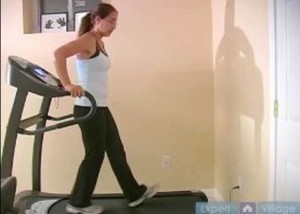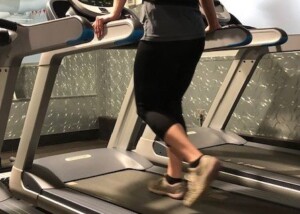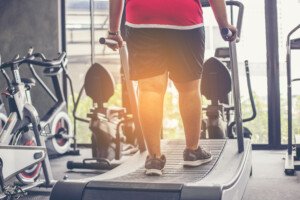
If you like using a manual (foot powered) treadmill but hold onto the rails, this is very wrong and defeats the purpose of this kind of machine.
Holding on cancels out or undoes the benefit of the foot-powered apparatus.
As a former personal trainer, I was inspired to write this article after seeing a woman “walking” on a manual treadmill at a fast speed.
Her hands were clutching the side rails at every moment, arms stiffly bent and tense, shoulders locked up, posture skewered. This is not the right way to walk.
She was actually slightly leaning over to one side, one arm more bent.
Her upper body was locked in this crooked position while her legs “walked” on the manually powered belt.
In short, her holding onto this manual treadmill was wrecking her posture through-and-through.
She was wasting her time. I just could not believe what I was seeing.
What is the point of using a foot-powered treadmill when you’re going to clutch the rails?
Every so often she intentionally jerked in an attempt to get more out of the “walking,” pulling harder on the hand rails with each step.
By the way, it was easy for me to observe her because I just happened to be working out at a station that was facing her about 30 feet away.
I thought, “If you want to up the ante of your walking, take your hands off the rails!”
Manual Treadmill: Why You Should Not Hold Onto the Rails
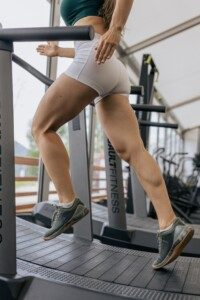
Pexels/Anastasia-shuraeva
If you’re not holding on, the muscles in your legs and glutes are doing all of the work. YOUR CORE IS ALSO VERY INVOLVED.
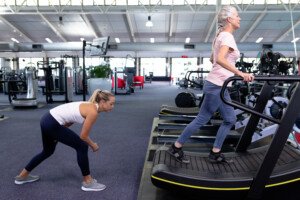
It’s easy to see that the walker’s core is getting a free ride as she grips the side rails. Letting go will force her body to improve balance. If she goes slowly enough, she will NOT fall off. Shutterstock/wavebreakmedia
Leg muscles burn more calories than arm muscles. So if burning calories is important to you, do not hold onto the rails.
Ignore the calorie display: This is triggered by the speed, not the person using the apparatus.
What if you don’t care about calories burned?
If you don’t care and are focused more on a cardio and fitness workout, then again, do not hold on. This messes up posture and creates a false sense of “I had a good workout.”
“The same rules should apply to both manual and motorized treadmills when it comes to holding on,” begins Dr. Tom Carpenter, corrective exercise specialist, certified personal trainer and chiropractor, inventor of Stand Corrected™, a portable harness-like stretching tool that helps alleviate back, neck and shoulder pain.
Dr. Carpenter continues, “Being hands free will engage the entire core and kinetic chain, enabling the body to recruit all of its posture and balancing muscles.
“Although there are other pros and cons to motorized versus manual treadmills, letting go of the rails is important when using either one.”
Let Go of the Manual Treadmill and Feel the Difference
If you walk without holding onto the manual treadmill, you’ll instantly feel a big difference: Your feet are truly powering the tread, rather than just gliding through the motions.
Don’t think for a moment that just because the treadmill is powered by your feet, that it’s okay to hold on.
- It’s not.
- This is cheating.
- It’s not real walking, even though there’s no electric motor.
- Your hand placement on the rails, especially a solid grip, subtracts significant workload from your legs, hips and feet!
Fear of Falling off a Manual Treadmill
• Walk slowly at first. The woman I saw was charging along and perhaps felt that if she let go she’d get thrown off.
• Walk SLOWLY. And just stay at that slow pace, without holding on, until you feel in control.
• Then gradually move faster. This is a manual treadmill, not a tight rope.
Walking on a manual treadmill without holding on will force your core muscle group to work!
It will force good posture! It will strengthen your ankles and calves. Need I say more?
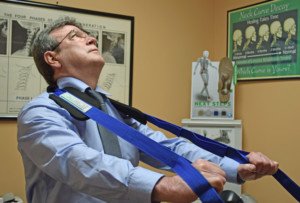
Photo credit: Aleesia Forni
Based upon 30+ years of experience, Dr. Carpenter’s practice approach reflects his belief that restoring optimum health and function will enable his patients to enjoy a much greater amount of vitality and wellness. Chiropractic care is true health care, not sick care!
 Lorra Garrick has been covering medical, fitness and cybersecurity topics for many years, having written thousands of articles for print magazines and websites, including as a ghostwriter. She’s also a former ACE-certified personal trainer.
Lorra Garrick has been covering medical, fitness and cybersecurity topics for many years, having written thousands of articles for print magazines and websites, including as a ghostwriter. She’s also a former ACE-certified personal trainer.
.

